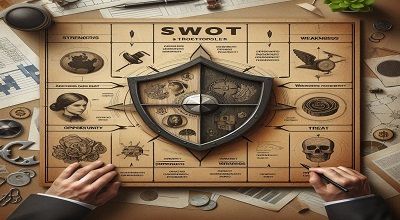SWOT
A SWOT analysis is a technique used to evaluate a company’s competitive position and to develop strategic planning. It involves identifying the internal strengths and weaknesses of a business, as well as the external opportunities and threats that it faces. A SWOT analysis can help a business to improve its performance, gain a competitive advantage, and achieve its goals.
A SWOT analysis consists of four categories:
- Strengths: These are the positive attributes and resources that a business has, such as a strong brand, loyal customer base, unique technology, or skilled workforce. Strengths can help a business exploit opportunities and overcome threats.
- Weaknesses: These are the negative aspects and limitations that a business faces, such as a weak reputation, high costs, outdated products, or poor customer service. Weaknesses can hinder a business from achieving its potential and make it vulnerable to threats.
- Opportunities: These are the favorable external conditions and trends that a business can benefit from, such as a growing market, new customer segments, emerging technologies, or favorable regulations. Opportunities can help a business to grow, diversify, or innovate.
- Threats: These are the unfavorable external factors and risks that a business has to deal with, such as a declining market, intense
Note:
A SWOT analysis can help ABC Inc. leverage its strengths, overcome its weaknesses, exploit its opportunities, and mitigate its threats. For example, ABC Inc. can use its high-quality products and services to attract more customers and increase its market share. Also reduce its production costs by finding alternative suppliers or improving its efficiency.
It can expand into new markets by diversifying its product portfolio and partnering with other businesses. It can also adopt e-commerce and social media to enhance its online presence and reach more customers. By doing a SWOT analysis, ABC Inc. can identify its current situation and plan for its future.
Difference between SWOT and PEST analysis
A SWOT analysis and a PEST analysis are two different frameworks that can help with strategic planning. They have some similarities and differences in their focus, usability, and scope.
Here is a brief comparison of SWOT and PEST analysis:
- Focus: A SWOT analysis focuses on the internal strengths and weaknesses of a business, as well as the external opportunities and threats that it faces. A PEST analysis focuses on the external political, economic, social, and technological factors that affect a business environment.
- Usability: A SWOT analysis is useful for evaluating a specific project, product, service, or the entire business. It can help a business to improve its performance, gain a competitive advantage, and achieve its goals. A PEST analysis is useful for assessing the feasibility and attractiveness of entering a new market or launching a new product. It can help a business to identify the opportunities and risks in the external environment.
- Scope: A SWOT analysis is more flexible and can be applied to various situations and contexts. It can also be combined with other frameworks, such as PEST, to get a more comprehensive analysis. A PEST analysis is more specific and can be used to analyze a particular industry, sector, or country. It can also be extended to include other factors, such as environmental, legal, or ethical, to form a PESTEL analysis.
Note:
Both SWOT and PEST analysis can provide valuable insights for strategic planning, but they have different purposes and applications. Depending on the situation and the objective, a business can choose the most suitable framework or use both of them together.
